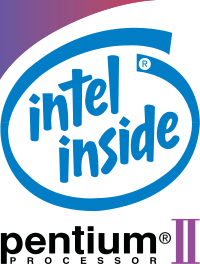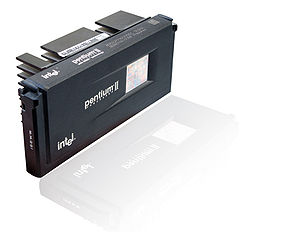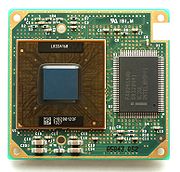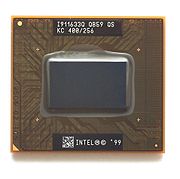- Pentium II
-
Pentium II 
Produced From mid 1997 to early 1999 Common manufacturer(s) - Intel
Max. CPU clock rate 233 MHz to 450 MHz FSB speeds 66 MHz to 100 MHz Min. feature size 0.35µm to 0.25µm Instruction set IA-32, MMX Microarchitecture P6 Cores 1 Socket(s) - Slot 1
- MMC-1
- MMC-2
- Mini-Cartridge
- Others
Core name(s) - Klamath
- Deschutes
- Tonga
- Dixon
The Pentium II[1] brand refers to Intel's sixth-generation microarchitecture ("P6") and x86-compatible microprocessors introduced on May 7, 1997. Containing 7.5 million transistors, the Pentium II featured an improved version of the first P6-generation core of the Pentium Pro, which contained 5.5 million transistors. However, its L2 cache subsystem was a downgrade when compared to Pentium Pros. In early 1999, the Pentium II was superseded by the Pentium III.
In 1998, Intel stratified the Pentium II family by releasing the Pentium II-based Celeron line of processors for low-end workstations and the Pentium II Xeon line for servers and high-end workstations. The Celeron was characterized by a reduced or omitted (in some cases present but disabled) on-die full-speed L2 cache and a 66 MT/s FSB. The Xeon was characterized by a range of full-speed L2 cache (from 512 KB to 2048 KB), a 100 MT/s FSB, a different physical interface (Slot 2), and support for symmetric multiprocessing.
Contents
Overview
The Pentium II microprocessor was largely based upon the microarchitecture of its predecessor, the Pentium Pro, but with some significant improvements.
Unlike previous Pentium and Pentium Pro processors, the Pentium II CPU was packaged in a slot-based module rather than a CPU socket. The processor and associated components were carried on a daughterboard similar to a typical expansion board within a plastic cartridge. A fixed or removable heatsink was carried on one side, sometimes using its own fan.[2]
This larger package was a compromise allowing Intel to separate the secondary cache from the processor while still keeping it on a closely coupled back-side bus. The L2 cache ran at half the processor's clock frequency, unlike the Pentium Pro, whose off die L2 cache ran at the same frequency as the processor. However, the smallest cache size was increased to 512 KB from the 256 KB on the Pentium Pro. Off-package cache solved the Pentium Pro's low yields, allowing Intel to introduce the Pentium II at a mainstream price level.[3][4] This arrangement also allowed Intel to easily vary the amount of L2 cache, thus making it possible to target different market segments with cheaper or more expensive processors and accompanying performance levels.
Intel notably improved 16-bit code execution performance on the Pentium II, an area in which the Pentium Pro was at a notable handicap. Most consumer software of the day was still using at least some 16-bit code, because of a variety of factors. The Pentium II went to 32 KB of L1 cache, double that of the Pentium Pro, as well. The Pentium II was also the first P6-based CPU to implement the Intel MMX integer SIMD instruction set which had already been introduced on the Pentium MMX.[3]
The Pentium II was basically a more consumer-oriented version of the Pentium Pro. It was cheaper to manufacture because of the separate, slower L2 cache memory. The improved 16-bit performance and MMX support made it a better choice for consumer-level operating systems, such as Windows 9x, and multimedia applications. Combined with the larger L1 cache and improved 16-bit performance, the slower and cheaper L2 cache's performance impact was reduced. General processor performance was increased while costs were cut.[3][5]
Variants
Klamath
The original Klamath Pentium II microprocessor (Intel product code 80522) ran at 233 and 266 MHz and were produced in a 0.35 µm process.[3][6] A 300 MHz version was released later in 1997.[6] These CPUs had a 66 MHz front side bus and were initially used on motherboards equipped with the aging Intel 440FX Natoma chipset designed for the Pentium Pro.[7]
In Intel's "Family/Model/Stepping" scheme, Klamath CPUs are family 6, model 3.
Deschutes
The Deschutes core Pentium II (80523), which debuted at 333 MHz in January 1998, was produced with a 0.25 µm process.[6] The 333 MHz variant was the final Pentium CPU that used the older 66 MHz front side bus; all subsequent Deschutes-core models used a 100 MHz FSB. Later in 1998, Pentium IIs running at 266, 300, 350, 400, and 450 MHz were also released.[6] The Deschutes core supported FXSAVE and FXRSTOR instructions, as opposed to Klamath. The die size was 113 mm 2. Towards the end of its design life, Deschutes chips capable of 500MHz within Intel cooling and design specifications were produced. However, these were not marketed. Rather than destroy already multiplier-locked units, those Deschutes units that had been tested and locked with a multiplier of 5 were sold as being 333MHz. This was accomplished by disabling the 100MHz bus option. Overclockers, upon learning of this, purchased the units in question and ran them well over 500MHz; most notably, when overclocking, the final batch of "333MHz" CPUs were capable of speeds much higher than CPUs sold at 350, 400, or 450 MHz.
Pentium II-based systems using the Intel 440LX Balboa chipset were the first to utilize the new generation RAM-standard, SDRAM (which replaced EDO RAM), and the AGP graphics bus.[8] Concurrent with the release of Deschutes cores supporting a 100 MHz front side bus was Intel's release of the 440BX Seattle chipset and its related cousins, the 440MX, 440NX, and 440ZX chipsets. Introduction of the 100 MHz front side bus speed resulted in solid performance improvements for the Pentium II lineup.
The Pentium II Xeon was a high-end version of Deschutes core intended for use on workstations and servers. Principally, it used a different type of slot (Slot 2), case, board design, and more expensive full-speed custom L2 cache, which was off-die. Versions were produced with 512 KB, 1 MB or 2 MB L2 caches by varying the number of 512 KB chips incorporated on the board.[9]
In Intel's "Family/Model/Stepping" scheme, Deschutes CPUs are family 6, model 5 and have the part number 80523.
Pentium II OverDrive
In 1998, the 0.25 μm Deschutes core was utilized in the creation of the Pentium II Overdrive processor, which was aimed at allowing corporate Pentium Pro users to upgrade their aging servers. Combining the Deschutes core in a flip-chip package with a 512 KB full-speed L2 cache chip from the Pentium II Xeon into a Socket 8-compatible module resulted in a 300 or 333 MHz processor that could run on a 60 or 66 MHz front side bus. This combination brought together some of the more attractive aspects of the Pentium II and the Pentium II Xeon: MMX support/improved 16-bit performance and full-speed L2 cache, respectively.[10] The later "Dixon" mobile Pentium II would emulate this combination with 256 KB of full-speed cache.
In Intel's "Family/Model/Stepping" scheme, the Pentium II OverDrive CPU identifies itself as family 6, model 3, though this is misleading, as it not based on the family 6/model 3 Klamath core. As noted in the Pentium II Processor update documentation from Intel, "Please note that although this processor has a CPUID of 163xh, it uses a Pentium II processor CPUID 065xh processor core."[11]
Tonga
The 0.25 μm Tonga core was the first mobile Pentium II and had all of the features of the desktop models.
In Intel's "Family/Model/Stepping" scheme, Tonga CPUs are family 6, model 5.
Dixon
Later, in 1999, the 0.25 μm Dixon core with 256 KB of on-die full speed cache was produced for the mobile market. Reviews showed that the Dixon core was the fastest type of Pentium II produced.[6]
In Intel's "Family/Model/Stepping" scheme, Dixon CPUs are family 6, model 6 and their Intel product code is 80524. These identifiers are shared with the Mendocino Celeron processors.
Core specifications
Desktop
Klamath (80522)
- L1 cache: 16 + 16 KB (Data + Instructions)
- L2 cache: 512 KB, as external chips on the CPU module clocked at half the CPU frequency.
- Packaging: Slot 1 module
- MMX
- Front-side bus: 66 MHz, GTL+
- VCore: 2.8 V
- Process: 0.35 µm CMOS
- First release: May 7, 1997
- Clockrate: 233, 266, 300 MHz
Deschutes (80523)
- L1 cache: 16 + 16 KB (Data + Instructions)
- L2 cache: 512 KB, as external chips on the CPU module clocked at half the CPU frequency.
- Packaging: Slot 1 module
- MMX
- Front-side bus: 66, 100 MHz, GTL+
- VCore: 2.0 V
- Process: 0.25 µm CMOS
- First release: January 26, 1998
- Clockrate: 266 - 450 MHz
- 66 MHz FSB : 266, 300, 333 MHz
- 100 MHz FSB: 350, 400, 450 MHz
Deschutes (Pentium II Overdrive)
- L1 cache: 16 + 16 KB (Data + Instructions)
- L2 cache: 512 KB external chip on CPU module running at 100% of CPU speed
- Socket: Socket 8
- Front-side bus: 60 or 66 MHz, GTL+
- VCore: 3.1-3.3 V (Has on-board voltage regulator)
- Fabrication: 0.25 µm
- Based on the Deschutes-generation Pentium II
- First release: 1998
- Supports MMX technology
- The sSpec number SL2KE denotes a Pentium II Overdrive sold with an integrated heatsink/fan combination for Socket 8. [Note that the sSpec number SL2EA denotes a Pentium II Overdrive sold with an integrated heatsink but no fan for Slot 1.]
Mobile
Tonga (80523)
Mobile Pentium II
- L1 cache: 16 + 16 KB (Data + Instructions)
- L2 cache: 512 KB, as external chips on the CPU module clocked at half the CPU frequency.
- Package: MMC-1, MMC-2, Mini-Cartridge
- MMX
- Front side bus: 66 MHz, GTL+
- VCore: 1.6 V
- Process: 0.25 µm CMOS
- First release: June 7, 1997
- Clockrate: 233, 266, 300 MHz
Dixon (80524)
Mobile Pentium II PE ("Performance Enhanced")
- L1 cache: 16 + 16 KB (Data + Instructions)
- L2 cache: 256 KB, on-die, full speed.
- Package: BGA1, MMC-1, MMC-2, μPGA1
- MMX
- Front-side bus: 66, 100 MHz, GTL+
- VCore: 1.5, 1.55, 1.6 V, 2.0 V
- Process: 0.25 µm CMOS
- First release: January 25, 1999
- Clockrate: 266, 300, 333, 366, 400 MHz
See also
- List of Intel Pentium II microprocessors
- Intel Celeron
References
- ^ "Microprocessor Hall of Fame". Intel. Archived from the original on 2007-07-06. http://web.archive.org/web/20070706032836/http://www.intel.com/museum/online/hist_micro/hof/. Retrieved 2007-08-11.
- ^ Pabst, Thomas. Intel's Slot 1 CPUs Uncovered, Tom's Hardware, May 3, 1998.
- ^ a b c d Pabst, Thomas. The Intel Pentium II ('Klamath') CPU, Tom's Hardware, March 1, 1997.
- ^ Lal Shimpi, Anand. Intel Pentium II, Anandtech, May 30, 1997.
- ^ Pabst, Thomas. The Empire Strikes Back: Intel's Pentium II CPU, Tom's Hardware, April 30, 1997.
- ^ a b c d e IA-32 implementation Intel P2 (incl. Celeron and Xeon), SandPile.org, accessed May 5, 2007.
- ^ Intel 440FX, PCGuide, accessed May 5, 2007.
- ^ Intel 440LX, PCGuide, accessed May 5, 2007.
- ^ Pabst, Thomas. Intel's Pentium II Xeon Processor, Tom's Hardware, July 2, 1998.
- ^ Wayback machine archive of Heise, accessed June 17, 2009
- ^ Specification Update for the Pentium II Processor
External links
- Listing of various PII, PIII, and Celeron alphanumeric model designations
- CPU-INFO: Intel Pentium II, indepth processor history
Intel datasheets
Intel processors Discontinued BCD oriented (4-bit) pre-x86 (8-bit) Early x86 (16-bit) x87 (external FPUs) IA-32 (32-bit) x86-64 (64-bit) Other Current Lists Microarchitectures P5 P5 based cores 800 nm - P5
600 nm - P54C
350 nm - P54CS
- P55C
250 nm - Tillamook
P6 P6 / Pentium M / Enhanced Pentium M based cores 500 nm 350 nm - P6
- Klamath
250 nm - Mendocino
- Dixon
- Tonga
- Covington
- Deschutes
- Katmai
- Drake
- Tanner
180 nm - Coppermine
- Coppermine T
- Timna
- Cascades
130 nm - Tualatin
- Banias
90 nm - Dothan
- Stealey
65 nm - Tolapai
- Yonah
- Sossaman
NetBurst NetBurst based cores 180 nm 130 nm 90 nm 65 nm Core Core / Penryn based cores 65 nm 45 nm - Penryn
- Penryn-QC
- Wolfdale
- Yorkfield
- Wolfdale-DP
- Harpertown
- Dunnington
Bonnell Bonnell based cores 45 nm - Silverthorne
- Diamondville
- Pineview
- Lincroft
- Tunnel Creek
- Sodaville
32 nm - Cedarview
- Cedar Trail-M
Nehalem Nehalem / Westmere based cores 45 nm - Clarksfield
- Lynnfield
- Jasper Forest
- Bloomfield
- Gainestown (Nehalem-EP)
- Beckton (Nehalem-EX)
32 nm - Arrandale
- Clarkdale
- Gulftown (Westmere-EP)
- Westmere-EX
Sandy Bridge Sandy Bridge / Ivy Bridge based cores 32 nm - Sandy Bridge
Future Categories:- Intel x86 microprocessors
- 1997 introductions
Wikimedia Foundation. 2010.







